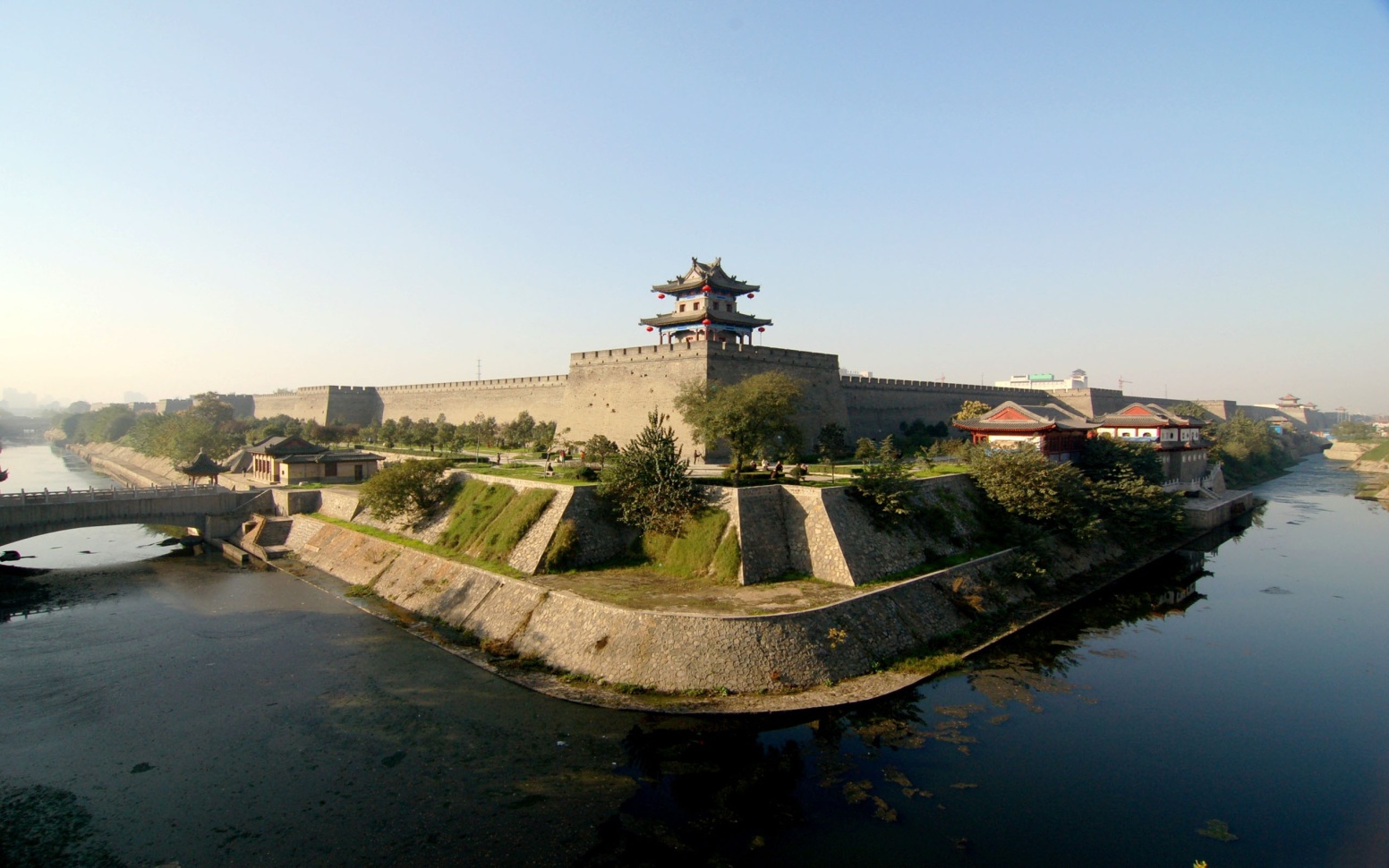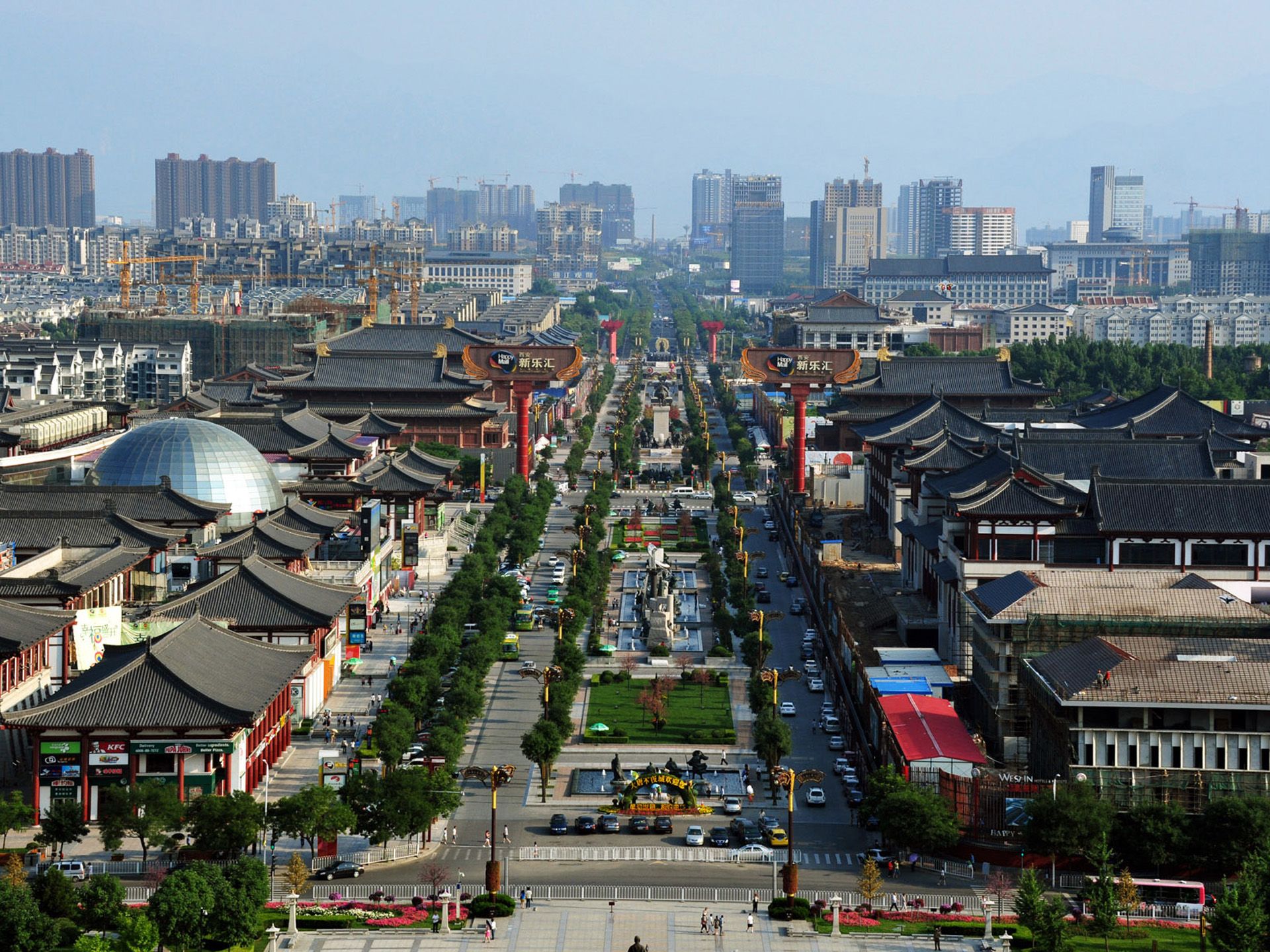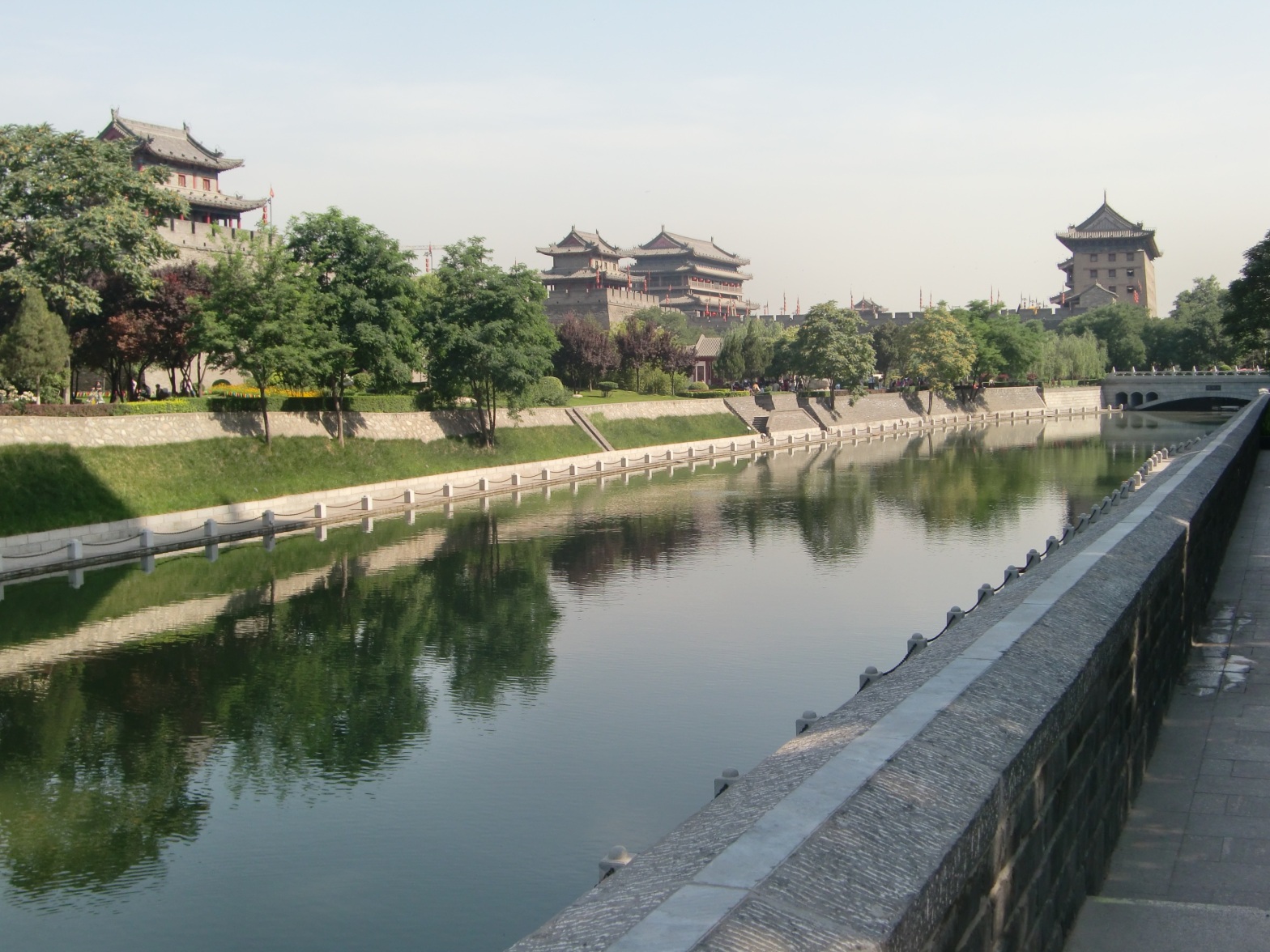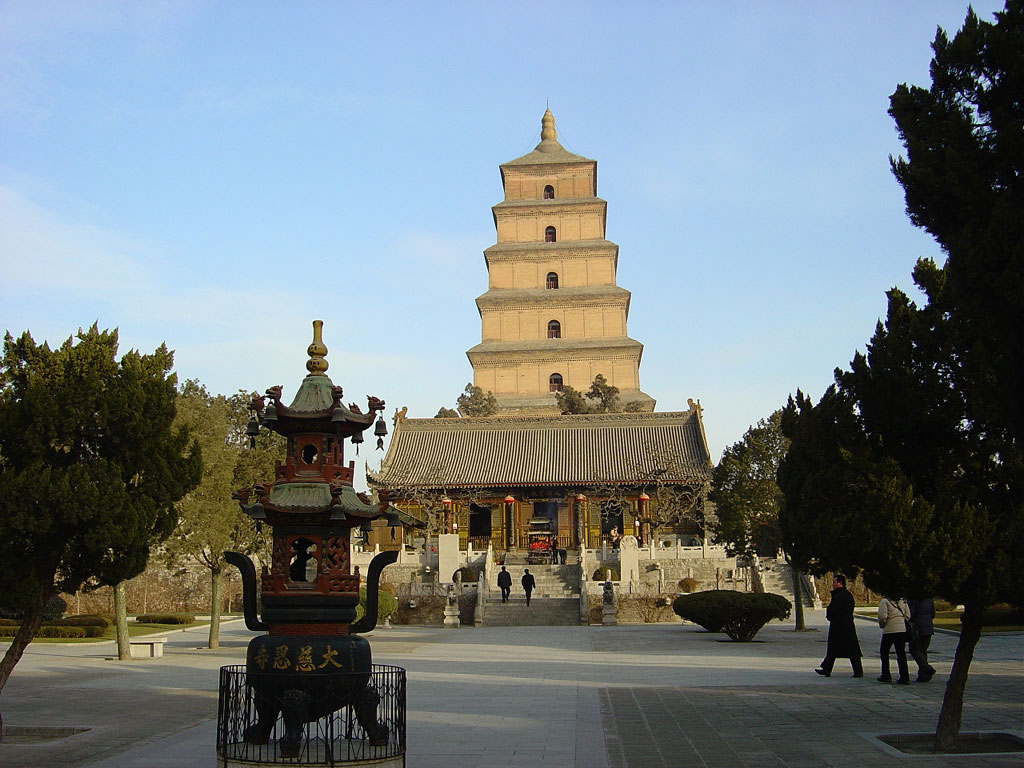
西安市,古称长安、京兆、镐京,位于中华人民共和国中部,紧邻中华人民共和国几何中心,现为国家中心城市、陕西省省会,是陕西省的政治、经济、文化、交通、医疗、教育中心[3][4][5][6]。西安拥有3000余年的文明史、建城史和1077年的建都史,历史上曾有包括周、秦、汉、隋、唐等在内的共13个中原朝代在此建都,也是汉唐时期丝绸之路的起点。西安是中国历史上强盛的统一王朝建都最多的古都[7],在西安定都的周、秦、汉、唐,代表了中国帝王时期开放、外向、尚武、繁荣的顶峰。从文明曙光的半坡到西周礼乐;从大秦一统到汉唐盛世;西安曾经在两千年的时间跨度中作为中国首都和政治、经济、文化中心,被誉为“天然历史博物馆”,是联合国教科文组织确立的世界历史名城之一,以及国际著名的旅游目的地城市,西安目前有两项六处世界文化遗产,数量居于全国前列。2011年,国务院发布《全国主体功能规划》,西安规划为中国唯一的“历史文化基地”。
西安位于关中平原的中部,渭水东南岸,地处中国中心,是长三角、珠三角和京津冀通往西北和西南的门户城市与重要交通枢纽,位于陇海铁路上,区位显著,交通畅达。在地理环境上,西安北濒渭河,南依秦岭,并有八水环绕。
西安是中国国家中心城市之一,丝绸之路经济带、新亚欧大陆桥及黄河流域重要城市,关中城市群的经济、科技、教育、能源、金融、文化、商贸中心,中国大飞机的制造基地之一,是陕西省政治、经济、文化中心,现辖11区2县,总面积10108平方公里,城市建成区面积505平方公里(2013年),常住人口1200万人,户籍人口905.68万人。2009年经国务院批准《关中—天水经济区发展规划》,提出将西安建设成为国家重要的科技研发中心、区域性商贸、物流、会展中心、区域性金融中心、国际一流旅游目的地以及全国重要的高新技术产业和先进制造业基地,着力打造西安国际化大都市,2013年国务院批复成立西咸新区,成为中国第七个国家级新区。2017年成立的中国(陕西)自由贸易试验区管辖的大部分片区位于西安市境内。2018年2月,国家发展和改革委员会、住房和城乡建设部发布《关中平原城市群发展规划》支持西安建设国家中心城市、国际性综合交通枢纽、建成具有历史文化特色的国际化大都市。
In der Chinesische Geschichte und heutzutage ist Xian eine der wichtigsten Städten Chinas. Sie war die erste Chinesische Stadt, die nach außen öffnete.Während der Tang-Dynastie war sie die wichtige Station in der Seidenstraße. Über 1000 Jahre lang war Xian Hauptstadt für zwölf Dynastien. Als Ausgangspunkt der Seidenstraße war sie Rom und Konstantinopel gleichgestellt. Aufgrund dieser langen Geschichte sind in Xi'an heute noch eine große Anzahl von Kunstdenkmälern, alten Tempeln und Ruinen, kaiserlichen Mausoleen und Gartenanlagen, Pavillions, Lauben und Türmen, Gedenkbogen und Steingravuren zu besichtigen. Heute ist Xian die Hauptstadt der Provinz Shanxi und eines der wichtigsten Industrie- und Wissenschaftszentren Chinas.(Quelle:http://www.tourchina.de/city_guide_xian.html)
Xi’an (chinesisch 西安, Pinyin Xī’ān, W.-G. Hsi-An ‚Westlicher Frieden‘, IPA [-ɕi-an], veraltet nach Post Sian), historisch auch: Xi’an Fu (西安府, Xī’ān Fǔ ‚Amtssitz der Präfektur Xī’ān‘, veraltet nach Post Sianfu), ist die Hauptstadt der chinesischen Provinz Shaanxi und eine der 15 Unterprovinzstädte Chinas. Xi’an besitzt eine nahezu vollständig erhaltene Stadtmauer und war der Ausgangspunkt der Seidenstraße. Die Stadt ist Sitz der Universität Nordwestchinas und Ausgangspunkt für Besichtigungen der Terrakotta-Armee.
西安市(せいあんし/シーアンし、簡体字: 西安市、拼音: Xī'ān、英語: Xi'an)は中華人民共和国陝西省の省都であり、古くは中国古代の諸王朝の都となった長安である。国家歴史文化名城に指定され、世界各国からの観光客も多い。経済的重要性から大幅な自主権をもつ副省級市にも指定されている。
西安の古称は長安であり、かつては西都、西京、大興、京兆、奉元等とも称された。古代より政治の中心地として西周から秦、漢から隋、唐の都城と十数の王朝の都として千年の歴史を有す古都である。
1369年(洪武2年)、明朝は元朝の奉元路を廃止し西安府を設置、これが西安の名称の初見である・明末の李自成の反乱に際しては、西安に入城した李自成は一時長安と改称したが、清朝により再び西安と改称され中華民国まで沿襲された。1928年、西安に初めて市制が施行され省轄市としての西安市が成立した。1948年には国民政府行政院轄市に改編、中華人民共和国成立後は延安に代わって陝甘寧辺区の首府となり、西北行政区轄市、中央直轄市、計画単列市と改編が続き、1954年に陝西省の省都、副省級市となって現在に至っている。
1900年の義和団の乱では西太后ら皇族が戦火の北京を逃れ西安に避難している。また1936年には国共合作による日本政府への対抗を目指す張学良が蒋介石を軟禁した西安事件の舞台となった都市でもある。
2004年、西北大学が日本人遣唐留学生井真成の墓誌を市内から発見して話題となったこともある。
Xi'an is the capital of Shaanxi Province, China. A sub-provincial city on the Guanzhong Plain in northwestern China,[4] it is one of the oldest cities in China, and the oldest of the Four Great Ancient Capitals, having held the position under several of the most important dynasties in Chinese history,[5] including Western Zhou, Qin, Western Han, Sui, and Tang.[5] Xi'an is the starting point of the Silk Road and home to the Terracotta Army of Emperor Qin Shi Huang.[6]
Since the 1990s, as part of the economic revival of inland China especially for the central and northwest regions, the city of Xi'an has re-emerged as an important cultural, industrial and educational centre of the central-northwest region, with facilities for research and development, national security and space exploration. Xi'an currently holds sub-provincial status, administering 9 districts and 4 counties.[7] As of 2018 Xi'an has a population of 12,005,600, and the Xi'an-Xianyang metropolitan area a population of 12.9 million.[3] It is the most populous city in Northwest China, as well as one of the three most populous cities in Western China.[8] In 2012, it was named as one of the 13 emerging megacities, or megalopolises, in China.[9]
Xi'an (chinois : 西安 ; pinyin : Xī'ān ; littéralement : « paix de l'Ouest » ; EFEO Si-ngan-fou) est la capitale de la province du Shaanxi en Chine. Elle a le statut de ville sous-provinciale. Cette ville, qui a une histoire de plus de 3 100 ans, a été la capitale de la Chine et se nommait alors Chang'an. L'actuelle Xi'an se classe dans les dix plus grandes villes chinoises. Elle compte plus de huit millions d'habitants enregistrés.
Xi'an (西安S, Xī'ānP - ascolta[?·info]), nota in italiano anche come Sian, è il capoluogo della provincia dello Shaanxi nella Cina e città sub-provinciale.
Conosciuta come una delle più importanti città nella storia cinese, Xi'an è nella lista della quattro grandi capitali antiche della Cina perché fu capitale di ben 13 dinastie, incluse la Zhou, la Qin, la Han e la Tang. Xi'an è la fine più orientale della Via della seta. La città ha più di 3.100 anni di storia. Era chiamata Chang'an (長安T, 长安S, Cháng'ānP, letteralmente "Pace Perpetua"), nei tempi antichi, oppure Hao (鎬T, HàoP) ancor prima.
Xi'an è la più grande e più sviluppata città nel centro della Cina nord-occidentale e si posiziona fra le prime città cinesi per popolazione. È anche sede universitaria di rilievo.
Xi'an (en chino: 西安, pinyin: Xī'ān, transcripción antigua: Hsian, literalmente: "Paz Occidental") es la capital de la provincia de Shaanxi en China. Xi'an cuenta con 3.225.812 habitantes y su municipalidad con alrededor de más de 8 millones de habitantes.2 Es mundialmente famosa porque en sus proximidades se encontraron los guerreros de terracota del emperador Qin Shi Huang. Xi'an está considerada el extremo oriental de la Ruta de la Seda.
Сиа́нь (кит. трад. 西安, пиньинь: Xī'ān, палл.: Сиань) — город субпровинциального значения в провинции Шэньси (КНР), место пребывания правительства провинции.
Город существует более 3100 лет, некоторое время являлся самым крупным (как по площади, так и по числу жителей) городом мира. Сиань — один из самых знаменательных исторических и культурных центров Китая, был столицей 13 династий Китая, в частности в периоды Чжоу, Цинь, Хань, Суй и Тан. Столицы этих государств располагались обычно в разных местах на небольшом удалении от центра современного Сианя.
Старое название города — Чанъань (кит. трад. 長安, упр. 长安, пиньинь: Cháng'ān, палл.: Чанъань), в переводе «долгий мир». Город Сиань (Чанъань) был местом назначения торговых караванов, которые шли по Великому шёлковому пути в Китай. В окрестностях города расположены курганные гробницы Древнего Китая, включая мавзолей Цинь Шихуанди c терракотовой армией.
С 1990 года, в соответствии с планом экономического развития Китая для центральных и северных регионов страны, Сиань преобразовался в важный центр культуры, образования и промышленности.









 Architecture
Architecture
 History
History



